View this article in another language
- 한국어
- English
- 日本語
- 中文
- العربية
- Español
- Français
- Deutsch
- Pусский
- Tiếng Việt
- Indonesian
*This is the seventh part in our series, “Gat, traditional headgear in Korea.”
The Transmission and Preservation of Gat: Humans Weaving a Tradition
Horsehair crafts and artisans
The gat, a style of horsehair hat, served as a status symbol and was part of one’s formal outerwear, declaring that the wearer was an educated, honorable man, similar to a classical scholar. Different materials were used so as to give the formal headpiece a unique and distinctive style. As a handicraft with exceptional beauty, the diverse shapes the hat can take reflect the changes in fashion over time. Such beauty and charm can be said to be derived from the process of making the hat. The traditional hat is the fruit of a great many labors and a great deal of time and effort by three skilled artisans and can be broken down into 50 steps.
Gats are made of diverse materials, such as horsehair, bamboo, silk thread and silk cloth. To make one requires delicate production techniques and scientific precision to create the unique shape. Making the hat is divided into three main processes: first, make the chongmoja, the cylindrical crown; second, wave the yangtae, the brim; third, join the two parts to complete the hat. In other words, three skilled artisans are required. The chongmoja-jang weaves the crown. The yangtae-jang makes the brim. The ipja-jang assembles the crown and the brim and coats the finished headgear with silk.
The creation of a single piece of the hat involves a thorough process that requires deft craftsmanship during each of its 51 steps. There are 24 steps to make the brim by splitting the bamboo to make a bamboo thread that is thinner than a hair. There are 17 steps to make the crown of horsehair. Finally, there are 10 steps to properly join the two parts. Although each component is made by going through different processes, just like the division of labor, it is the artisans’ exquisite skill embedded in each step that brings about the completion of a work of clothing art.
The history of gat can be viewed as the history of the gat artisan. According to the Gyeonggukdaejeon, the book of National Code, there were 116 artisans making official hats in 7 categories at the beginning of the Joseon Dynasty (1392-1910). That figure increased to 1,524 across 26 categories in the later Joseon Dynasty, as recorded in the Uigwe, the records of royal banquets. As the type of official hat craftsmen was broken down during the later Joseon era, compared to earlier times, the number of artisans significantly increased. For example, the workmanship of the yangtae-jang was further subdivided into the yangtae-jang and the yeonjuk-jang and the work of the moja-jang was subdivided into duties for a moja-jang, a dugeon-jang and a ieom-jang.
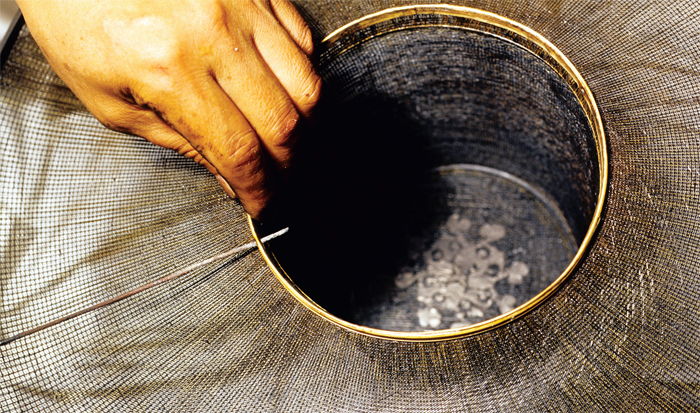
In addition, the manggeon-jang, who made the maggeon or headband, was divided into the mami-jang who handled the horsehair, the mangsu-jang who made the front part of the headband, the eomang-jang who specialized in making the king’s headband, and the gwanja-hang who made mainly the ornaments that went on the headband. Although Jeju Island presently serves as the center of any horsehair craft, such artisan works were common all over the peninsula during the Joseon period, particularly in Jeongju and Taecheon in Pyeongan Province, in Jeongpyeong in Hamgyeong Province, in Gadeok Island in Gyeongsang Provice, and then more broadly in Jeolla Province and on Jeju Island.
By the end of the Japanese colonial period in the early 1900s, a fair number of gat workshops were in business in some regions, including Gimje, Yecheon and Daegu. However, after the liberation of Korea from Japanese colonial rule in 1945, reduced demand for the hat resulted in a remarkable decline in the number of workers, and only a few artisans were engaged in the business. In those days, men had to dress up in traditional clothes, including the overcoat, the dopo, and the traditional long coat, the durumagi, along with the gat. These were worn at formal occasions, such as ancestral rituals and weddings, which led to some modest demand for the traditional attire. However, in the 1960s the traditional ceremonial clothes gradually disappeared, thereby bringing about another drop in the demand for horsehair hats. In 1964, the Korean government, determined to safeguard disappearing traditional craftsmanship, designated Korea’s national craft technique as an Important Intangible Cultural Heritage item and began fostering the transmission of craft skills to the next generation. As part of these efforts, three types of gat-making artisans--chongmoja-jang, yangtae-jang and ipja-jang--were designated as skill holders of Important Intangible Cultural Heritage Item No. 4, with the aim of preserving and transmitting their unique skills and techniques.
Currently, there are five active masters designated as gannil, or gat makers, by the central government. They include: honorary master Kim In and Kang Sun-ja, both chongmoja-jangs; Jang Sun-ja who is a yangtae-jang; and, Chung Choon-mo and Park Chang-yeong who are both ipja-jang. In addition, there are masters designated by local governments: Song Ok-su, born in 1925, is the gobun yangtae-jang of Jejudo Island and is Intangible Cultural Heritage Item No. 12; and, Jang Jeong-sun, born in 1947, who is a yangtae-jang and is Gyeonggi Province Intangible Cultural Heritage Item No. 51. All these artisans endeavor to hand down the tradition of gat making.
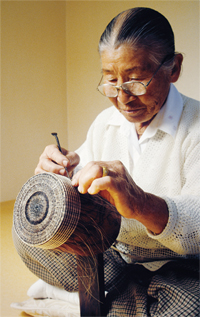 Chongmoja-jang
Chongmoja-jang
Kim In
Born in 1920
Date of Designation: February 1, 1985
Awards: 1980, 1981 and 1984 won awards in the 5th, 6th and 9th Korean Annual Traditional Handicraft Exhibitions
Activities: 1985-present, works to exhibit traditional crafts of important intangible cultural heritage items
Kim In, born in Dodu-dong, on Jeju Island, started learning the skills of weaving the chongmoja part of the gat when she was living under the tutelage of Oh Song-juk, the first holder of such skills. On February 1, 1985, she was designated as a chongmoja-jang of gannil and she is Important Cultural Heritage Item No. 4.
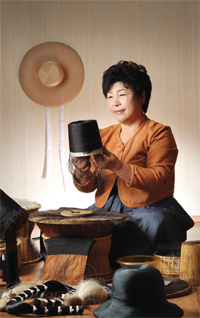
Kang Sun-ja
Born in 1946
Date of Designation: September 25, 2009
Awards: 1987 awarded the 12th Korean Annual Traditional Handicraft Art Exhibition
Activities: 2009-present, works to exhibit traditional crafts of important intangible cultural heritage items
Kang Sun-ja is the daughter of Kim In, the honorary master of gannil, who is also part of Important Cultural Heritage Item No. 4. She inherited the skills of making the chongmoja from her mother and served as a skill holder since she was designated in September 2009. Her daughter, Yang Yun-hee, has been designated as a scholarship apprentice, and is ready to carry on the third generation of the family business.
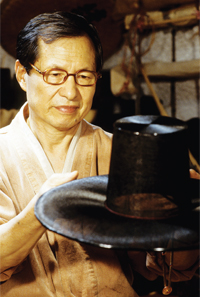
Ipja-jang
Chung Choon-mo
Born in 1940
Date of Designation: May 1, 1991
Awards: 2001, received the Appreciation Plaque from the prime minister,
1986 he won the Prize of the Minister of Culture and Information at the 9th Korean Annual Traditional Handicraft Art Exhibition,
1987 he won the Silver Award at the Korean Annual Traditional Handicraft Art Exhibition Activities:
1991-present, he works on exhibitions of traditional handicrafts and important intangible cultural heritage items,
1984 he donated a gat to the Vatican Museum in Rome, Italy ,and another to Yonsei University in Seoul.
Chung Choon-mo, born in Yecheon, North Gyeongsang Province, first learned the skills of making gat in 1958 under the guidance of Lee Jong-guk, who had been running a gat workshop as his family business for three generations. Between 1976 and 1978, he was apprenticed to Go Jae-ju, a chongmoja skill holder, to learn the skills for making the chongmoja. By 1980, he had mastered the methods of making the yangtae, as well.
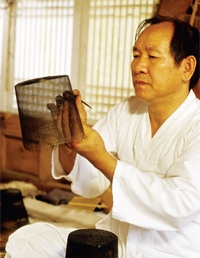
Park Chang-yeong
Born in 1943
Date of Designation: July 22, 2000
Awards: 1973-1989 he won prizes several times at the Korean Annual Traditional Handicraft Art Exhibition
Activities: 2000-present, he works on exhibitions of traditional crafts and important cultural heritage items, in 2004 he donated a gat to the Lee Young Hee Museum of Korean Culture in New York, USA.
Park Chang-yeong was born into a family that had been involved in making gats for four generations in Yecheon, North Gyeongsang Province. His family members all worked in the gat workshop, including the chongmoja and the yangtae. Since he was designated as a skill holder and part of Important Intangible Cultural Heritage Item No. 4 in 2000, he has been more active in making and presenting a diverse range of traditional haps, including the jurip, the baekrip and the heukrip.
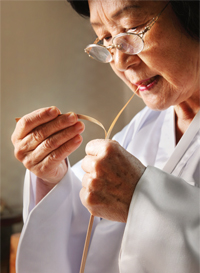
Yangtae-jang
Jang Sun-ja
Born in 1940
Date of Designation: July 22, 2000
Awards: 1992, received the Plaque of Meritorious Services from the Governor of Jeju Province, since 1982 she won awards eight times in the yangtae category of the Korean Annual Traditional Handicraft Art Exhibition
Activities: 2000-present, she has worked on exhibits of traditional crafts and of important intangible cultural heritage items, 2000 was appointed as a sinjisikim, or pioneer, by Jeju Province.
Jang Sun-ja chose to be a third-generation yangtae-jang, following in the footsteps of her maternal grandmother, Kang Sun-il, and her mother, Go Jeong-saeng. At her mother’s suggestion, at the age of 23 she once worked in the bamboo business supplying bamboo to brim-makers. When she turned 43, her mother was designated as a skill holder of an important intangible cultural heritage item by the Korean government. At that time, Jang began learning the work of making the yangtae in earnest.
*This series of article has been made possible through the cooperation of the National Research Institute of Cultural Heritage. (Source: Intangible Cultural Heritage of Korea)
The Transmission and Preservation of Gat: Humans Weaving a Tradition
Horsehair crafts and artisans
The gat, a style of horsehair hat, served as a status symbol and was part of one’s formal outerwear, declaring that the wearer was an educated, honorable man, similar to a classical scholar. Different materials were used so as to give the formal headpiece a unique and distinctive style. As a handicraft with exceptional beauty, the diverse shapes the hat can take reflect the changes in fashion over time. Such beauty and charm can be said to be derived from the process of making the hat. The traditional hat is the fruit of a great many labors and a great deal of time and effort by three skilled artisans and can be broken down into 50 steps.
Gats are made of diverse materials, such as horsehair, bamboo, silk thread and silk cloth. To make one requires delicate production techniques and scientific precision to create the unique shape. Making the hat is divided into three main processes: first, make the chongmoja, the cylindrical crown; second, wave the yangtae, the brim; third, join the two parts to complete the hat. In other words, three skilled artisans are required. The chongmoja-jang weaves the crown. The yangtae-jang makes the brim. The ipja-jang assembles the crown and the brim and coats the finished headgear with silk.
The creation of a single piece of the hat involves a thorough process that requires deft craftsmanship during each of its 51 steps. There are 24 steps to make the brim by splitting the bamboo to make a bamboo thread that is thinner than a hair. There are 17 steps to make the crown of horsehair. Finally, there are 10 steps to properly join the two parts. Although each component is made by going through different processes, just like the division of labor, it is the artisans’ exquisite skill embedded in each step that brings about the completion of a work of clothing art.
The history of gat can be viewed as the history of the gat artisan. According to the Gyeonggukdaejeon, the book of National Code, there were 116 artisans making official hats in 7 categories at the beginning of the Joseon Dynasty (1392-1910). That figure increased to 1,524 across 26 categories in the later Joseon Dynasty, as recorded in the Uigwe, the records of royal banquets. As the type of official hat craftsmen was broken down during the later Joseon era, compared to earlier times, the number of artisans significantly increased. For example, the workmanship of the yangtae-jang was further subdivided into the yangtae-jang and the yeonjuk-jang and the work of the moja-jang was subdivided into duties for a moja-jang, a dugeon-jang and a ieom-jang.

In addition, the manggeon-jang, who made the maggeon or headband, was divided into the mami-jang who handled the horsehair, the mangsu-jang who made the front part of the headband, the eomang-jang who specialized in making the king’s headband, and the gwanja-hang who made mainly the ornaments that went on the headband. Although Jeju Island presently serves as the center of any horsehair craft, such artisan works were common all over the peninsula during the Joseon period, particularly in Jeongju and Taecheon in Pyeongan Province, in Jeongpyeong in Hamgyeong Province, in Gadeok Island in Gyeongsang Provice, and then more broadly in Jeolla Province and on Jeju Island.
By the end of the Japanese colonial period in the early 1900s, a fair number of gat workshops were in business in some regions, including Gimje, Yecheon and Daegu. However, after the liberation of Korea from Japanese colonial rule in 1945, reduced demand for the hat resulted in a remarkable decline in the number of workers, and only a few artisans were engaged in the business. In those days, men had to dress up in traditional clothes, including the overcoat, the dopo, and the traditional long coat, the durumagi, along with the gat. These were worn at formal occasions, such as ancestral rituals and weddings, which led to some modest demand for the traditional attire. However, in the 1960s the traditional ceremonial clothes gradually disappeared, thereby bringing about another drop in the demand for horsehair hats. In 1964, the Korean government, determined to safeguard disappearing traditional craftsmanship, designated Korea’s national craft technique as an Important Intangible Cultural Heritage item and began fostering the transmission of craft skills to the next generation. As part of these efforts, three types of gat-making artisans--chongmoja-jang, yangtae-jang and ipja-jang--were designated as skill holders of Important Intangible Cultural Heritage Item No. 4, with the aim of preserving and transmitting their unique skills and techniques.
Currently, there are five active masters designated as gannil, or gat makers, by the central government. They include: honorary master Kim In and Kang Sun-ja, both chongmoja-jangs; Jang Sun-ja who is a yangtae-jang; and, Chung Choon-mo and Park Chang-yeong who are both ipja-jang. In addition, there are masters designated by local governments: Song Ok-su, born in 1925, is the gobun yangtae-jang of Jejudo Island and is Intangible Cultural Heritage Item No. 12; and, Jang Jeong-sun, born in 1947, who is a yangtae-jang and is Gyeonggi Province Intangible Cultural Heritage Item No. 51. All these artisans endeavor to hand down the tradition of gat making.

Kim In
Born in 1920
Date of Designation: February 1, 1985
Awards: 1980, 1981 and 1984 won awards in the 5th, 6th and 9th Korean Annual Traditional Handicraft Exhibitions
Activities: 1985-present, works to exhibit traditional crafts of important intangible cultural heritage items
Kim In, born in Dodu-dong, on Jeju Island, started learning the skills of weaving the chongmoja part of the gat when she was living under the tutelage of Oh Song-juk, the first holder of such skills. On February 1, 1985, she was designated as a chongmoja-jang of gannil and she is Important Cultural Heritage Item No. 4.

Kang Sun-ja
Born in 1946
Date of Designation: September 25, 2009
Awards: 1987 awarded the 12th Korean Annual Traditional Handicraft Art Exhibition
Activities: 2009-present, works to exhibit traditional crafts of important intangible cultural heritage items
Kang Sun-ja is the daughter of Kim In, the honorary master of gannil, who is also part of Important Cultural Heritage Item No. 4. She inherited the skills of making the chongmoja from her mother and served as a skill holder since she was designated in September 2009. Her daughter, Yang Yun-hee, has been designated as a scholarship apprentice, and is ready to carry on the third generation of the family business.

Ipja-jang
Chung Choon-mo
Born in 1940
Date of Designation: May 1, 1991
Awards: 2001, received the Appreciation Plaque from the prime minister,
1986 he won the Prize of the Minister of Culture and Information at the 9th Korean Annual Traditional Handicraft Art Exhibition,
1987 he won the Silver Award at the Korean Annual Traditional Handicraft Art Exhibition Activities:
1991-present, he works on exhibitions of traditional handicrafts and important intangible cultural heritage items,
1984 he donated a gat to the Vatican Museum in Rome, Italy ,and another to Yonsei University in Seoul.
Chung Choon-mo, born in Yecheon, North Gyeongsang Province, first learned the skills of making gat in 1958 under the guidance of Lee Jong-guk, who had been running a gat workshop as his family business for three generations. Between 1976 and 1978, he was apprenticed to Go Jae-ju, a chongmoja skill holder, to learn the skills for making the chongmoja. By 1980, he had mastered the methods of making the yangtae, as well.

Park Chang-yeong
Born in 1943
Date of Designation: July 22, 2000
Awards: 1973-1989 he won prizes several times at the Korean Annual Traditional Handicraft Art Exhibition
Activities: 2000-present, he works on exhibitions of traditional crafts and important cultural heritage items, in 2004 he donated a gat to the Lee Young Hee Museum of Korean Culture in New York, USA.
Park Chang-yeong was born into a family that had been involved in making gats for four generations in Yecheon, North Gyeongsang Province. His family members all worked in the gat workshop, including the chongmoja and the yangtae. Since he was designated as a skill holder and part of Important Intangible Cultural Heritage Item No. 4 in 2000, he has been more active in making and presenting a diverse range of traditional haps, including the jurip, the baekrip and the heukrip.

Yangtae-jang
Jang Sun-ja
Born in 1940
Date of Designation: July 22, 2000
Awards: 1992, received the Plaque of Meritorious Services from the Governor of Jeju Province, since 1982 she won awards eight times in the yangtae category of the Korean Annual Traditional Handicraft Art Exhibition
Activities: 2000-present, she has worked on exhibits of traditional crafts and of important intangible cultural heritage items, 2000 was appointed as a sinjisikim, or pioneer, by Jeju Province.
Jang Sun-ja chose to be a third-generation yangtae-jang, following in the footsteps of her maternal grandmother, Kang Sun-il, and her mother, Go Jeong-saeng. At her mother’s suggestion, at the age of 23 she once worked in the bamboo business supplying bamboo to brim-makers. When she turned 43, her mother was designated as a skill holder of an important intangible cultural heritage item by the Korean government. At that time, Jang began learning the work of making the yangtae in earnest.
*This series of article has been made possible through the cooperation of the National Research Institute of Cultural Heritage. (Source: Intangible Cultural Heritage of Korea)
![Gat, traditional headgear in Korea [6]](/upload/content/image/1393924045608.jpg)
![Gat, traditional headgear in Korea [5]](/upload/content/image/1393319340768.jpg)
![Gat, traditional headgear in Korea [4]](/upload/content/image/1392690825210.jpg)
![Gat, traditional headgear in Korea [3]](/upload/content/image/1392095636707.jpg)
![Gat, traditional headgear in Korea [2]](/upload/content/image/1391590339998.jpg)
